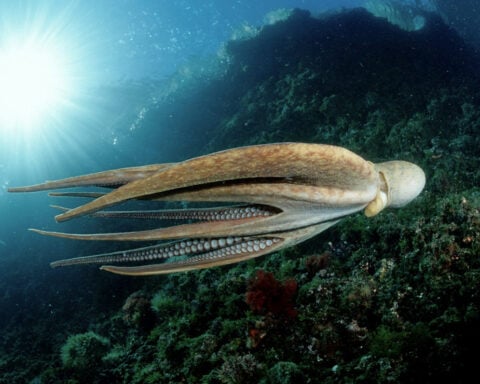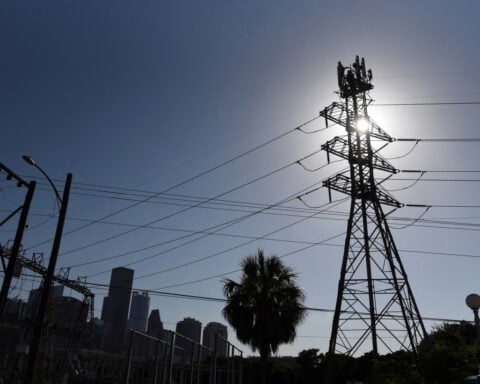(CNN) — Keep your eyes on the night skies to see the elusive Draconid meteor shower, expected to peak Monday evening into early Tuesday.
Unlike many meteor showers, the Draconids aren’t ones you’ll have to stay up late to witness because the shower is most visible just after nightfall and throughout the evening hours, rather than the early morning, according to EarthSky. And the moon will be only 27% illuminated in its current phase, which will allow better visibility of the faint meteors once night falls.
However, the Draconid meteor shower is on the sparse side. Expect to see a few meteors — about 10 at most — streak across the sky per hour. The peak of the meteor shower is predicted to occur at 11 p.m. ET Monday.
Meteor showers occur as our planet passes through debris trails left behind by comets and asteroids, which eject bits of rock and ice as they orbit the sun. The Draconids are the result of Earth intersecting with such a trail from the comet 21P/Giacobini-Zinner when it nears the comet’s orbit in October each year.
The shower gets its name because the meteors appear to be coming from the direction of the constellation Draco the Dragon. But the Draconids are sometimes referred to as the Giacobinids in honor of the comet’s discoverer, Michel Giacobini, who spotted the celestial object in 1900.
The Draconid meteors move slower than those witnessed during other showers, meaning they can be visible for one or two seconds.
A meteor storm
The chance of witnessing an outburst of Draconids meteors streaking across the sky, called a meteor storm, can be a captivating possibility for stargazers. Although it’s a “sleepy” shower compared with some of the larger showers — which typically produce more meteors more quickly — later this year, “the dragon” can be full of surprises.
Meteor storms can happen when a comet’s debris is concentrated close to the comet, rather than spread out, as Earth passes through the trail. Hundreds or thousands of meteors can be visible per hour during a meteor storm.
The Draconids caused a meteor storm in 1933 and 1946, with thousands of meteors per hour, and European sky-gazers reported more than 600 meteors per hour during the event in 2011.
The comet 21P/Giacobini-Zinner completes an orbit of the sun about every seven years, and the last time it made its closest approach to Earth, in September 2018, many reported seeing an outburst during the meteor shower. The next close approach of the comet won’t occur until 2025, but an outburst is always possible.
Viewers from the Southern Hemisphere will only have a narrow opportunity to see the shower as soon as darkness falls Monday because the Draco constellation doesn’t really rise above the horizon in that part of the world, according to EarthSky.
The best way to view the meteor shower is by sitting in a reclining lawn chair or lying on your back and looking up at the sky with a wide view. No special equipment is needed, but if you want the best viewing conditions, it helps to be as far from artificial light as possible.
If you live in an urban area, you might want to take a drive to avoid city lights, which can make the meteor shower seem faint. Camping out in the country can triple the number of visible meteors, scientists from NASA said.
And don’t forget to grab your camera before you head out. Meteor showers are a great opportunity for time-lapse videos and long-exposure photography.
Upcoming celestial events
The next full moon, the hunter’s moon occurring on October 17, will be a supermoon and the closest of the year at 222,095 miles (357,428 kilometers) away.
The beaver moon will occur on November 15, and the final full moon of the year will be the cold moon on December 15.
Meanwhile, sky-gazers can anticipate a busy meteor shower season to close out 2024. Here are peak dates for upcoming celestial activity, according to the American Meteor Society:
Orionids: October 20-21
Southern Taurids: November 4-5
Northern Taurids: November 11-12
Leonids: November 17-18
Geminids: December 13-14
Ursids: December 21-22
The-CNN-Wire
™ & © 2024 Cable News Network, Inc., a Warner Bros. Discovery Company. All rights reserved.

 How to save a fentanyl victim: Key facts about naloxone
How to save a fentanyl victim: Key facts about naloxone
 Eight convicted in France over murder of teacher who showed Prophet caricature
Eight convicted in France over murder of teacher who showed Prophet caricature
 Death toll from German Christmas market car-ramming rises to four, Bild reports
Death toll from German Christmas market car-ramming rises to four, Bild reports
 France's Mayotte struggles to recover as cyclone overwhelms hospitals
France's Mayotte struggles to recover as cyclone overwhelms hospitals
 Russia's UK embassy denounces G7 loans to Ukraine as 'fraudulent scheme'
Russia's UK embassy denounces G7 loans to Ukraine as 'fraudulent scheme'
 Pope calls Gaza airstrikes 'cruelty' after Israeli minister's criticism
Pope calls Gaza airstrikes 'cruelty' after Israeli minister's criticism
 Retailer Party City files for bankruptcy, will wind down 700 stores
Retailer Party City files for bankruptcy, will wind down 700 stores
 Soccer's top players have had enough, as FIFA's new super-sized tournament sparks a revolt
Soccer's top players have had enough, as FIFA's new super-sized tournament sparks a revolt
 Lindsey Vonn finishes 14th in a super-G to mark her return to World Cup skiing at age 40
Lindsey Vonn finishes 14th in a super-G to mark her return to World Cup skiing at age 40
 Santa and Mrs. Claus use military transports to bring Christmas to an Alaska Native village
Santa and Mrs. Claus use military transports to bring Christmas to an Alaska Native village








